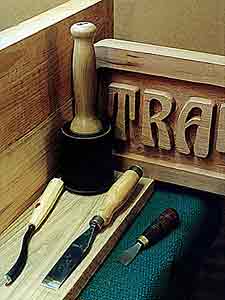 |
|
 |
| Quality
Hand Carved Signs in Wood are not cheap:
Design is unique.
Malcolm Wall has no catalogue of standard signs. Each is custom-designed
for the client.
Skills are specialized.
The creation of these signs involves techniques ranging from
relief and incised carving to applique, woodcuts and gold leafing.
Materials are high quality.
Malcolm uses the best woods, properly seasoned, together
with quality glues, and the finest finishes appropriate for the purpose
of the sign. Hanging hardware is stainless steel.
Potential customers may be familiar with other signmaking
techniques which cater to mass production. For rough comparison purposes,
sand blasted cedar signs (which Malcolm respects but does not make) are
now being priced at $125 (US) per square foot. Carved wood signs will be
more expensive than these. Pricing of Malcolm Wall’s signs reflects
their individual nature, quality materials, and the skills and care which
Malcolm brings to bear for each sign he creates. In short, Malcolm believes
very strongly in providing excellent value for money.
|
  |
 Creating
a sign requires a cooperative approach between the customer and
the signmaker. Designing the sign is probably the most important stage.
No amount of good sign construction can salvage a poor design. A balanced
design is necessary, blending art with purpose. Therefore it is important
that the right questions are asked and the answers understood ... at the
outset. What is the sign intended to DO? (Sell a product, draw clients into
a shop, make a personal statement, name a home, provide directions, etc.)
Where is the sign to be displayed, and how much space is available for it?
What is the surrounding decor? Who are the target viewers of the sign (employees,
visitors, motorists, pedestrians)? Must the sign display logos or images
as well as lettering? Creating
a sign requires a cooperative approach between the customer and
the signmaker. Designing the sign is probably the most important stage.
No amount of good sign construction can salvage a poor design. A balanced
design is necessary, blending art with purpose. Therefore it is important
that the right questions are asked and the answers understood ... at the
outset. What is the sign intended to DO? (Sell a product, draw clients into
a shop, make a personal statement, name a home, provide directions, etc.)
Where is the sign to be displayed, and how much space is available for it?
What is the surrounding decor? Who are the target viewers of the sign (employees,
visitors, motorists, pedestrians)? Must the sign display logos or images
as well as lettering?
So how does the process work? Here is a typical sequence
of events:
 The
Customer expresses interest in a sign. An information exchange follows
regarding the sign purpose and design. The
Customer expresses interest in a sign. An information exchange follows
regarding the sign purpose and design.
 A
rough design and rough pricing are agreed. Note that at this point the
Customer is not liable for any expenses. A
rough design and rough pricing are agreed. Note that at this point the
Customer is not liable for any expenses.
 The
detailed design is developed, with a detailed estimate of costs prepared
in proposal form. The
detailed design is developed, with a detailed estimate of costs prepared
in proposal form.
 The
proposal is agreed upon by both parties, and the initial payment sent (normally
one-third of total). The
proposal is agreed upon by both parties, and the initial payment sent (normally
one-third of total).
 The
Signmaker creates the sign and delivers it to the Customer, at which point
the final payment is due. The
Signmaker creates the sign and delivers it to the Customer, at which point
the final payment is due.
|
|















